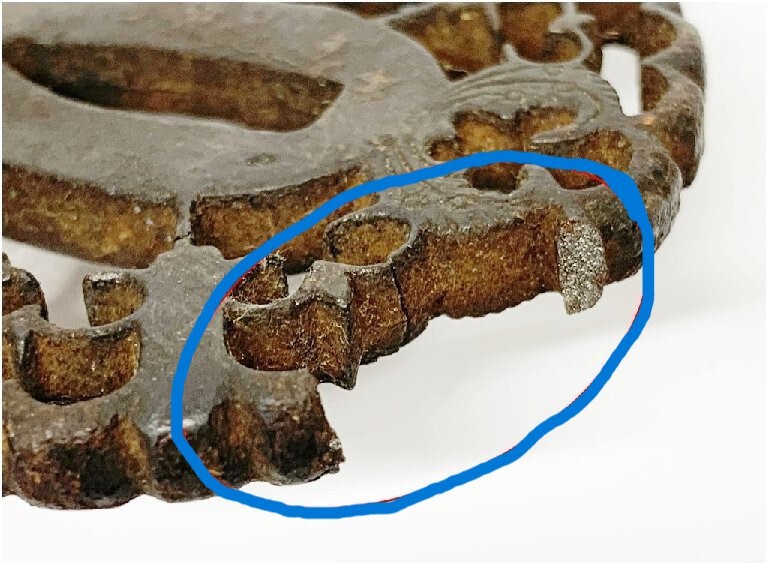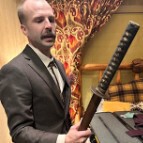
Dan tsuba
Gold Tier-
Posts
828 -
Joined
About Dan tsuba

- Birthday 05/08/1950
Profile Information
-
Location:
USA
-
Interests
Trying to explain (and show pictures of) possible alternative ways that tusba were made (other than being hand forged) in the Edo period (particularly on my “Tsuba casting molds ?” thread). Specifically, the possibility that cast iron tsuba were made (and sand cast or clay cast) in the Edo period. Not a popular subject, as it interferes with the status quo thinking of how tsuba were made in that period of Japanese history! Nonetheless, I think it is a subject worth considering!
Profile Fields
-
Name
Dan
Dan tsuba's Achievements
-
Collecting tsuba is a very interesting and educational hobby. Each collector has his own reasons for collecting his specific type of tsuba. Some collectors seem to collect tsuba that are expensive museum quality type tsuba (and those types of tsuba have been shown recently on this forum). Which is great for them, and if I wanted to I could afford to purchase a museum quality type tsuba. Now whether those museum quality type tsuba were ever mounted on a blade or used for other than royal court appearances is unknown. Remember that probably many samurai had more than one tsuba for each of their blades. Maybe one for royal court appearances, maybe one for daily wear, and maybe one for battles. I, on the other hand, prefer to collect tsuba that show their age and have probably actually been mounted on a blade and carried on a daily basis. It is similar to a collector of 1873 model Colt revolvers. In the first picture shown below is a presentation 1873 model Colt. It has probably never been fired or carried in a holster. The selling price was started at $50,000 dollars. The second picture is an 1873 model colt. It shows signs of use and wear and was more than likely carried in a holster for daily wear. The selling price was about $3,500 dollars. Collecting tsuba (for some) may be all about purchasing the most expensive tsuba that they can afford (maybe museum quality tsuba that may have never been mounted or carried for very long on a blade). But to some, it may be that they collect tusba (that are not museum quality pieces and are not super expensive) because those tsuba they collect were probably actually used and carried on a daily basis and thus are a link (both real and maybe spiritual) to the daily lives of the wearer and user of the piece. Just my opinion.
-
Off topic here, but this (once again) is getting personal because of some members frustrations with this thread. Rokujuro (Jean), Just because you are frustrated with what I am presenting on this thread (and for the most part you site no resources or references or show pictures to back up your stated opinions and statements in your posts) there is no reason to resort to name calling. I can only guess that you were referring to me when in your last post you stated, “Don’t feed the trolls!”
-
Hello again! I came across an interesting thread on this forum from 2023. https://www.militaria.co.za/nmb/topic/45170-mass-produced-tsuba/ It talks about mass produced tsuba, a few posts talk about cast iron tsuba and if those tsuba could have been made in the Edo period. Anyway, just some more interesting stuff!
-
Curran, A great post! You stated that “with each school and each maker, there are _SOFT_ rules about size, shape, finish, and %_percentage of seppa dai vs total volume displacement of the tsuba.” Also was stated “At least amongst the Higo schools, certain schools and certain generation had specific rules.” I am very interested in what you stated. Can you provide pictures or references that I can refer to about these rules? Thanks!
-
Hi Arnaud (OceanoNox). Great research on finding that Edo period publication! You stated that it has to do with making tsuba out of recycling old farming tools, and I did notice some pictures of tsuba in that publication. So, I figure you must have translated some of it. I appreciate you advising me how to translate the rest of it. However, I don’t have the technological tools or know how to translate it. Maybe someone on the forum can translate those pages with tsuba shown on it and post it? That would be very helpful! As an addendum to this post. I inquired on the internet “how many millions of Japanese edo period texts are awaiting to be translated into English”. This is what the internet stated- “There is no exact number, but there are certainly many thousands, and likely millions, of Edo period texts awaiting translation into English, though a comprehensive figure is not available. A vast amount of information from this fertile period of literature and art exists in handwritten and printed formats, and a significant portion of it has not yet been translated or studied in depth by English-speaking scholars. Factors contributing to the large volume of untranslated texts: Vast quantity of materials: The Edo period (1603–1867) was a time of significant population growth and increased literacy, leading to the creation of an enormous number of books, manuscripts, and other written materials. Variety of genres: Texts span numerous genres, including literature, history, philosophy, art, poetry, and practical guides, each requiring specialized translation skills. Complex language and script: Edo-era Japanese was written in a complex script using Chinese characters (kanji) and Japanese phonetic scripts (kana) that differs from modern Japanese, making translation a specialized and labor-intensive task. Limited resources for translation: The number of translators with the specific linguistic and historical knowledge needed to translate these texts is limited. Incomplete cataloging: While there are collections, many texts are not fully cataloged, making it difficult to even identify the full scope of what exists and needs translating.” Also, found this on the internet “Keeping Knowledge Secret in Edo Period Japan (1600-1868) found at this website- https://www.jstor.org/stable/48647105?seq=1 So. maybe there was stuff written about the making of cast iron tsuba in the Edo period that has not come to light yet or was kept secret? Who knows? Just some more interesting stuff.
-
Hi Brian, Kind of off topic here. So, in your last post you seem to be referring to instruction manuals written in the Edo period that tells and describes how to make an iron tsuba. In part of your post (which was referering to cast iron tsuba) you stated- “Clearly the Japanese were very embarrassed about doing it. Because they managed to hide all the old writings on it, pattern books, instruction manuals, pretty much all the documentation that they did routinely for all the other methods.” I would very much be interested to see those Edo period instruction manuals that describe and state, step by step, how to make a hand forged iron tsuba (hopefully they have been translated into English!) since as you stated- "pretty much all the documentation that they did routinely for all the other methods.” Could you please post some links or references so I can check them out? Thanks!
-
Well, my friends there you have it! If a tsuba was made from cast iron in the Edo period (and cast iron has a high carbon content) and then decarburized (to lower its carbon content) and in doing so make it more malleable for addition of motif or design, could that ever be determined or detected? Maybe even with non-invasive metallurgical testing, could that testing discern if it was first cast and then decarburized? Where is a university degreed metallurgical expert when you need one? Like I said before, maybe this thread needs to be locked? In my opinion nobody really knows anything, and everybody is just guessing. Only a few courageous members are willing to take a stand that cast iron tsuba were made in the Edo period. Just my opinion.
-
Well, I found an interesting comment to the Marcus Sesko article (which is a great article) about the Nara find of casting molds. That discovery initially started me on my journey on this thread about cast iron tsuba. I was referred to the Sesko article by a post on this thread dated 1/27/2022. I haven’t revisited that article until about an hour ago! What I found was a comment (written by another individual) added at the bottom of that article on 10/12/2022. The article by Sesko can be found here- https://markussesko.com/2016/01/20/cast-sword-fittings/ Here is what part of that comment stated- “I have long maintained that many sukashi tsuba were originally cast and then converted to malleable iron by carburisation – in effect by heating in firescale. We know this process is used for kettles, allowing the surface to be chiselled and otherwise worked. The commonly advocated method of their production, being cut out of a plate by sawing, would demand the existance of sawblades capable of intricate cuts, similar to modern piercing saw blades. By casting and then carburising, the basic form of the tsuba would then only need refning using files or even more likely scrapers.” Just some more interesting stuff!
-
Hey Kai, Welcome to this great forum! I like your tsuba even though it appears to have been overcleaned. I agree with Spartancrest that your tsuba was mounted at least twice. Also, another nice thing about your tsuba is that the kogai hitsu ana (one of the holes in the tsuba) has been filled. Which to me shows a kind of customization of the tsuba. I usually don't pay over $150 for a tsuba. I think you paid a fair price for yours.
-
My opinion here, but I liked the old ranking system better. How are the ranks derived at anyway? The number of threads one starts? The number of likes one gets? The number of posts one has? Maybe ranking should be given to an individual by the number of members that view a thread started by that individual and find that thread of interest? I mean, anyone can post something and get a number of likes (or not). But holding the interest of members on a thread over a period of time is something totally different all together, especially on a controversial type thread (let me think, who am I referreing to?) Just my opinion.
-
When the Dr. told me I had a cataract, I said no. I don't have a Cadillac, I have a Dodge! Of course, I went out and got hearing aids after that! Ha, ha, ha, etc. Again, way off topic here but I had to put my 2 cents in!
-
Jean. Once again, you just don't get it do you. You stated "Compare with real TSUBA!" Martin stated "Is it really Meiji era tsuba or otherwise? I mean it looks really nice so even if it was contemporary i would probably get it. It is priced around 40 Euros." Why can't you just support Martin in what he finds interesting to him? He already has stated that he thinks it may be Meiji. Real tsuba or otherwise, if he likes it, that what is important. Why do you always have to put someone down with your "Compare with real TSUBA". By capitilizing "TSUBA" what are you trying to say? Are you a "TSUBA" snob?
-
Martin, I like the tsuba! It is well done and maybe it is not cast, but machine cut. It is nicely painted and shows great detail (my opinion). I don't know! Maybe it was made in the last century? But it doesn't appear to have been mounted on a blade. But if you like it, that is the important thing! Onward!
-
Hi Martin, My opinion is that the tsuba looks modern and fairly recently made to me. But hey, if you like it that is all that matters! 40 euros is a fair price for a modern tsuba (again, my opinion!). Onward!
-
Hi Curran! What is that cryptic beer mug in your last post supposed to represent? This Buds for you! Thanks for your support, and I will also drink to that! Ha, ha, ha, ha, etc! Onward to more Edo period cast iron tsuba research!










